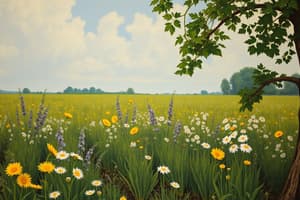Podcast
Questions and Answers
What are the five methods that help us classify weeds?
What are the five methods that help us classify weeds?
- Life cycle (ontogeny) (correct)
- Physiology (correct)
- Habitat (correct)
- Origin (correct)
- Taxonomy/morphology (correct)
What are two weed origins?
What are two weed origins?
Native/indigenous/apophytes and Alien/exotic/neophytes
Name three examples of alien invasive species in Canada.
Name three examples of alien invasive species in Canada.
Giant hogweed, Japanese knotweed, Leafy spurge
What are six examples of habitat classification?
What are six examples of habitat classification?
What is taxonomy in weed classification?
What is taxonomy in weed classification?
Plants with similar traits are NOT grouped together.
Plants with similar traits are NOT grouped together.
Many weeds are members of the _________ and _________ family.
Many weeds are members of the _________ and _________ family.
What are Dicots?
What are Dicots?
What are Monocots?
What are Monocots?
What are the three life cycles (life history) in weeds?
What are the three life cycles (life history) in weeds?
What is the life cycle of an annual weed?
What is the life cycle of an annual weed?
What are the characteristics of an annual weed?
What are the characteristics of an annual weed?
Do annuals produce an abundance of seeds?
Do annuals produce an abundance of seeds?
What is the mode of propagation in annual weeds?
What is the mode of propagation in annual weeds?
What are the two types of annual weeds?
What are the two types of annual weeds?
When do summer annuals germinate, grow, produce seeds and die?
When do summer annuals germinate, grow, produce seeds and die?
Name two examples of annual weeds.
Name two examples of annual weeds.
When do winter annuals germinate, grow, produce seeds, and die?
When do winter annuals germinate, grow, produce seeds, and die?
What is a facultative winter annual?
What is a facultative winter annual?
What is an obligate winter annual?
What is an obligate winter annual?
All other winter annual weeds are ____________ winter __________.
All other winter annual weeds are ____________ winter __________.
What are examples of facultative winter annuals? Name five.
What are examples of facultative winter annuals? Name five.
How long do biennials live?
How long do biennials live?
How does a biennial plant develop in the first and second year?
How does a biennial plant develop in the first and second year?
Biennials do NOT have roots as storage organs after the first year.
Biennials do NOT have roots as storage organs after the first year.
Biennials are usually a problem in arable agriculture.
Biennials are usually a problem in arable agriculture.
Common examples of biennials?
Common examples of biennials?
The plants live longer than _________ years and may __________ several times before __________.
The plants live longer than _________ years and may __________ several times before __________.
How do simple perennials reproduce?
How do simple perennials reproduce?
How do creeping perennials reproduce?
How do creeping perennials reproduce?
What are rhizomes?
What are rhizomes?
What are stolons?
What are stolons?
What are roots in the context of perennials?
What are roots in the context of perennials?
What are tubers?
What are tubers?
What are bulbs?
What are bulbs?
What are corms?
What are corms?
Woody perennials are common on arable lands.
Woody perennials are common on arable lands.
How are life cycles not always distinct? Name three examples.
How are life cycles not always distinct? Name three examples.
Physiology is based on what?
Physiology is based on what?
C4 plants do NOT have a more efficient photosynthetic process.
C4 plants do NOT have a more efficient photosynthetic process.
C3 plants are more common.
C3 plants are more common.
C4 plants do NOT thrive well in warm dry conditions.
C4 plants do NOT thrive well in warm dry conditions.
What are two weed management practices for alien invasive weeds?
What are two weed management practices for alien invasive weeds?
What are two weed management practices for native species?
What are two weed management practices for native species?
What are four examples of weed management practices for weed habitats?
What are four examples of weed management practices for weed habitats?
How does herbicide selection differ between Monocots and Dicots?
How does herbicide selection differ between Monocots and Dicots?
What is the main consideration with mowing for Monocots versus Dicots?
What is the main consideration with mowing for Monocots versus Dicots?
What are two methods for controlling perennial weeds?
What are two methods for controlling perennial weeds?
What are two methods for C3 versus C4 control?
What are two methods for C3 versus C4 control?
Flashcards are hidden until you start studying
Study Notes
Weed Classification Methods
- Classification of weeds can be based on five methods: origin, habitat, taxonomy/morphology, life cycle, and physiology.
Origin of Weeds
- Weeds can be categorized as native (indigenous/apophytes) or alien (exotic/neophytes).
- Examples of alien invasive species in Canada include giant hogweed, Japanese knotweed, and leafy spurge.
Habitat Classification
- Weeds can be classified based on their habitat:
- Agrestal
- Ruderals
- Grassland weeds
- Aquatic weeds
- Forest weeds
- Environmental weeds
Taxonomy in Weed Classification
- Taxonomy involves naming species based on morphological features, particularly reproductive structures.
- Taxonomic classification groups plants with similar traits together.
- Many weeds belong to the Poaceae (grass) and Asteraceae (composite) families.
- Dicots are seedlings that produce two cotyledons, while monocots produce one.
Life Cycles of Weeds
- Weeds have three life cycle types: annuals, biennials, and perennials.
- Annual weeds complete their life cycle from seed to seed in less than one year, characterized by shallow roots and weak stems, and produce a large number of seeds.
- Types of annual weeds include summer annuals (germinate in spring, grow in summer, die before winter) and winter annuals (germinate in fall, grow in spring, die in summer).
Biennial Weeds
- Biennial weeds live longer than one year but less than two; they develop vegetatively in the first year and flower in the second year after a cold period.
- They typically have roots as storage organs after the first year, and examples include common burdock, biennial wormwood, henbit, and common groundsel.
Perennial Weeds
- Perennials live longer than two years and can reproduce multiple times (polycarpic).
- Simple perennials generally reproduce by seed (e.g., foxtail barley, dandelion), while creeping perennials reproduce by seed and vegetative organs.
- Forms of vegetative reproduction include:
- Rhizomes: Underground stems (example: Johnson Grass).
- Stolons: Horizontal creeping stems above ground (example: Bermuda grass).
- Roots: Enlarged root systems with buds (example: field bindweed).
- Tubers: Modified rhizomes for food storage (example: Nutsedge).
- Bulbs: Modified stems that reproduce mainly through bulbs (example: Allium species).
- Corms: Modified shoots with fleshy stems (example: Timothy).
- Woody perennials are not common in arable lands.
Physiological Aspects of Weeds
- Physiological classification is based on photosynthesis, especially the conversion of light energy into chemical energy.
- C4 plants have a more efficient photosynthetic process than C3 plants, which are more common and include wild oat, lambsquarters, and dandelion.
- C4 plants thrive better in warm, dry conditions (e.g., redroot pigweed, kochia, green foxtail).
Weed Management Practices
- Alien Invasive Weeds: Management involves containing the spread and employing biological control strategies.
- Native Weeds: Focus on containment is less critical; strategies may involve herbicide use or mechanical weeding.
- Habitat management practices include mowing, spraying, grazing, and predation.
- Herbicide selection should depend on whether the weeds are monocots (grasses) or dicots (broadleaf plants).
- Timing of weed control for perennials is best in the fall, as perennials relocate reserves to their roots during this time, enhancing herbicide efficacy.
C3 vs. C4 Weed Control
- Under poor growing conditions, C4 weeds are more competitive with C3 crops.
- In changing climate conditions, C3 weeds can become more competitive with increasing CO2 levels.
Studying That Suits You
Use AI to generate personalized quizzes and flashcards to suit your learning preferences.




